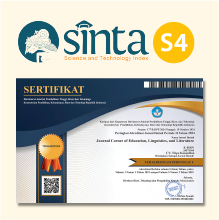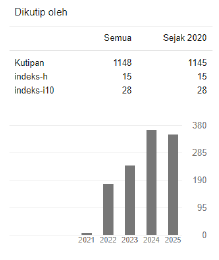The Effectiveness of Match Technique to Improve Students’ Vocabulary Mastery based on Gender
 https://doi.org/10.54012/jcell.v1i3.33
https://doi.org/10.54012/jcell.v1i3.33
 Abstract views: 620
Abstract views: 620
 PDF downloads: 676
PDF downloads: 676
Keywords:
Vocabulary, Make a Mtach Technique, Descriptive TextAbstract
This research that belongs to quantitative research aims at finding the effectiveness of make a match technique to improve students’ vocabulary based on gender. The instrument given to the students was vocabulary in the context of a descriptive text. The subject of this research consisted of 25 students. This research only used experimental class for this research. The result of this research, there were significant improvement between pre-test and post-test score. The result obtained from sample T-test, it was found that the p value (0,000) was lower than 0.05 and t-observed (25.296) was higher than t-table (2.064). While the result of differences score between female and male based on post test, the p value (.859) was higher than 0.05, there were not significant differences of vocabulary score between female and male. So, this technique make students interesting in teaching and learning vocabulary, this technique also helps students to understand about material easily.
Downloads
References
A S Hornby. (2010). “Oxford Advanced Learner‟s Dictionary of Curren English”, English Dicionary (5thed). Oxford:Oxford University Press
Arifah, M., & Kusumarasdyati. (2013). “The effectiveness of Make a Match Technique for teaching writing descriptive text to the seventh graders of SMPN 1 Karangbinangun Lamongan”. UNESA, I(1), 1-8. Retrieved from ejournal.unesa.ac.id/article/3061/58/article.pdf
Azizah, Nurul F. (2018). “The Implementation of Make a Match Technique to Increase Students’ Vocabulary Mastery”, Jurnal Edulingua, Vol 5, No. 2, 46-47.
Celce, Murcia and Olshtain. (2000). Discourseand Context in Language Teaching. Cambridge: Cambridge University Press
Creswell, J. (2014). Research design: Qualitative, Quantitative, and Mixed Methods Approaches (V. Knight (ed.); Fourth Edi). SAGE Publication. https://doi.org/10.4135/9781849208956
Creswell, J. W. (2012). Educational research: Planning, conducting, and evaluating quantitative and qualitative research (4th ed). Pearson
Hilbert Elfrida H and Kamil, Michael M. (2005). Teaching and Learning Vocabulary Bringing Research to Practice, (LEA) .New Jersey London
Huda, Miftahul. (2013). Model-model Pengajaran dan Pembelajaran. Yogyakarta: Pustaka Pelajar
Kamil, M and Hiebert, E. (2005). Teaching and Learning Vocabulary. Mahwah: Kawrence Erlbaum Associates.
Maduratna, Dewi. (2004). “The Impact of the Application of Make a Match Technique Towards Students’ Vocabulary Mastery.” The Second International Conference on Education and Language, 2, p. 290-294.
Nikmah, Ria Dhatun et al. (2018). “The Effectiveness of Make a Match Technique in Teaching Vocabulary.” Advances in Social Science, Education and Humanities Research
Richards, Jack C.&Renandya, W, A. (2002). Methodology in Language Teaching: An Anthology of Current Practice. New York: Cambridge University Press
Suprijono, A. (2010). Cooperative learning: Teori dan aplikasi PAIKEM (2nd Ed.). Yogyakarta:Pustaka Pelajar
Suprijono, A. (2009). Cooperative learning:Theory and Application of Paikem. Surabaya: Library Study.
Stahl, S. (2005). Four problems with teaching word meanings (and what to do to make vocabulary an integral part of instruction). In E. H. Hiebert and M. L. Kamil (Eds), Teaching and learning vocabulary: Bringing research to practice (pp. 95-114). Mahwah, NJ: Lawrence Erlbaum.
Terrell, S. R. (2012). Mixed-Methods Research Methodologies. The Qualitative Report, 17(1), 254–280.
Thornbury, Scott . (2002). How to teach Vocabulary .Essex: Person Educational Limited
Utami, Nia et al. (2018). “Improving Students’ Vocabulary through Make a Match Technique,” Jurnal Pendidikan dan Pembelajaran Khatulistiwa, Vol 7, No 12, 1-7.
Downloads
Published
How to Cite
Issue
Section
License
Copyright (c) 2022 Via Destika

This work is licensed under a Creative Commons Attribution-ShareAlike 4.0 International License.
All articles published in the Journal Corner of Education, Linguistics, and Literature are licensed under the Creative Commons Attribution-ShareAlike License (CC BY-SA).

















